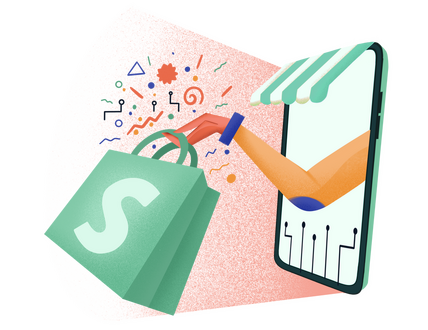When we think eCommerce, we usually think about physical products. You know--clothes, electronics...absurdly large wall-mounted feline jungle gyms.
The reality, though, is not all products can be packed onto the nearest Brown truck and shipped to your customers--but that shouldn’t stop you from selling them.
Fortunately, this is the Digital Age. eCommerce means what we want it to mean. If you have a brilliant digital product idea and don’t know how to take it to market--this post’s for you. If you’ve never thought of selling digital products on Shopify -- maybe you should.
Take it from the e-learning industry, which relies heavily on digital products and is expected to reach $374.3B USD by 2026.
That sweet sweet moolah isn’t restricted to just e-learning either. Regardless of your industry, digital products offer merchants several benefits that physical goods can’t. If sold correctly, they’re nearly effortless to consume and distribute. Ongoing production costs? Never heard of her. Create them once, then replicate sales into infinity.*
*Subject to necessary updates to stay relevant, but you get where we’re going.
Want to learn more about what digital products you can sell--and how to optimize your Shopify store to sell them? Of course you do. Read on, friend.
Digital Products You Can Sell With Shopify
Plot twist: all of them.
Due to Shopify’s unparalleled flexibility, there’s nothing (legal) you can’t sell on the platform. For the sake of brevity, we’ll cover just a few of the most popular digital products sold online today:
Gift Cards: lol duh. Gift cards are the OG digital product (and a godsend for last-minute holiday shoppers).
Software: The software market (which includes apps) has always been hugely profitable. Software makes us more productive, reinforces our marketing efforts, entertains grown adults with games built entirely around a new-age Candyland (still trying to figure that one out), and--best of all--kits our Shopify sites out with rad themes and all the features necessary to keep business humming.
eBooks and Digital Documents: While physical books aren’t going anywhere (who doesn’t love taking a giant whiff of those clean, new pages?), there is a growing demand for ebooks. Estimates show that 191 million ebooks were sold in the United States in 2020.
With the rapid development of digital communication and relatively recent emphasis on environment sustainability, digital documents have become a common form of distribution for resources like guidebooks, templates, and more.
Audio and Video: Audio and video products form another successful category of digital products. Think: audiobooks, training videos, podcasts, music files, and more.
Photos and Graphics: Calling all photographers! Did you know the stock photo industry is growing at a 5% average rate? That means a couple of things: 1) there’s demand for great stock photos and 2) the market’s only getting more saturated. It’s not going to make you a millionaire, but it’s a great example of the “one-time effort and long-term payoff” benefit of digital goods. If you were looking for a sign to kick your photography side gig into high gear, this is it!
Got design chops? Make that graphic wizardry work for you, from web iconography to tattoo designs to...doll clothing?
Pixie Faire is the largest online marketplace for doll clothing patterns. It not only features more than 50 indie designers, but also sells online courses on sewing, design, craft, and pattern-making. (There truly is a market for everything.)
Speaking of courses...
Courses: If you’re an expert in something, you can combine audio, video, and text files to create a course for aspiring learners. eLearning has been steadily gaining popularity over the last decade. Colleges and universities have been offering online courses for eons, and with the inception of platforms like Skillshare, Udemy, and Masterclass, anyone, anywhere, can learn to do just about anything--all at their own pace. Win, win, win! Best of all? You don’t have to chain yourself to one of those third-party platforms. You can sell your course products right through Shopify without losing money on a “service fee.”
NFTs: Messy. Confusing. Surprisingly harmful to the environment. From a bird’s eye view, most NFTs (“non-fungible tokens”) are part of the wonderful world of Ethereum blockchain. We could write multiple blog posts on these little crypto cool kid cash cows (and we'd all probably want to cry trying to understand it), but we’ll leave it at this: NFTs are basically the digital equivalent of Pokemon cards, for people who like to find innovative ways to spend (a lot of) money.
Disclaimer: While you can sell these bad boys on Shopify, we recommend against putting all your eggs in this basket unless you really understand the market, and--for the love of all that is holy--please don’t try to sell your Tweets. (It won’t work unless you’re Jack Dorsey, and even if you ARE him--cringe.)
How to Sell Digital Products with Shopify
Once you have some viable ideas for one or multiple digital products, you need an eCommerce platform to set up shop. Helloooo, Shopify!
The biggest benefit of Shopify is that you don’t need any programming skills or a large budget. Plus, there are over 100 themes you can choose from, along with 4,000+ apps, to determine your online store’s appearance and features.
Assuming you’re ready with a basic Shopify store configuration, there are two main ways to sell digital products:
One-off digital downloads: sell a digital product as a downloadable file, in exchange for a one-time payment. When a customer completes the checkout process, they are directed to a link to download the file.
Membership subscriptions: sell a monthly subscription to a growing collection of digital products. A customer might sign up for a monthly membership or pay for the whole year upfront to keep getting new products or an upgrade to existing products, month after month.
A (totally unbiased) side note: memberships are the sh*t.
How do you decide which model will work best for your business? It really depends on your priorities...
|
Benefits |
One-off Products |
Memberships |
|
Predictable Revenue |
❌ you can’t be sure how much you’re going to sell each month |
✅ you have a better sense of projected revenue |
|
Available cash |
❌ your cash flow relies on repeat purchases |
✅ you can offer memberships on a quarterly or annual basis, so customers pay upfront |
|
Marketing spend |
❌ you need to keep acquiring new customers |
✅ you don’t need new customers as often, especially if you leverage a loyalty program |
|
Up-selling and cross-selling opportunities |
❌ since your contact with customers is limited |
✅ since customers interact with your business more often |
|
Simple business operation |
✅ just deliver download links after checkout |
❌ you’ll need a subscription app like ReCharge to set up and manage recurring billing |
|
High conversion rate |
✅ it’s easier to sell a simple product |
❌ may take more effort to persuade potential buyers, since it’s more of a commitment |
|
Less time investment |
✅ not much work after initial setup |
❌ possibly more customer service time required; effort required to reduce churn; app updates and improvements |
OK, I know which model will work for me. What now?
Selling one-time digital products with Shopify
To sell a simple digital product with Shopify, you’ll need to install a third-party app from the Shopify App Store. It will provide a download link to customers when they complete a purchase.
One such app is Shopify’s own Digital Downloads app, which allows you to upload digital files to your store just like you would add a physical product. The process is as easy as installing and activating the app! Once activated, go to Products > All Products > Add Product.
Note: There are other apps that support the sale of digital products, but for the sake of this article, we’ll pretend you’ve selected Digital Downloads. The process described below will be much the same, regardless of the app you choose.
Fill in the relevant product details then scroll down to the Shipping section of the product page and uncheck the box that says “This is a physical product”.
This will communicate to Shopify that you intend to sell this product as a digital item or service.
Next, upload the digital file. Right below the product heading at the top, click More actions. Then select Add Digital Attachment.
Here, you can select the file to be uploaded from your device. When you’re done making changes to your product details, click Save Product.
Another important part of configuring the digital downloads app is to adjust the fulfillment settings for your digital items. Go to Apps > Digital Downloads.
Click the name of the digital product you added to Shopify. Select the gear icon to find Settings in the drop-down list, then, under fulfillment options, pick Automatically Create Fulfillment.
This ensures that after a successful payment, the download link will be automatically emailed to the buyer and their order will be marked as fulfilled.
Those are the basics, but you can always go to Apps > Digital Downloads to access additional settings and features. From there, you can:
- Manage your digital products
- Cancel downloads
- Export a CSV of all orders
- View download analytics
- Set download limits
- Resend download links
The Digital Downloads app is enough for basic needs, but if your digital product business takes off and gets more complex, you might consider more robust options like SendOwl.
While SendOwl will (probably) not accompany you on a 7-year journey to slay the Dark Lord and his many Death Eaters, it does offer a variety of additional features and automation capabilities, like setting an expiration date on links, generating license keys, and more.
Selling memberships/subscriptions with Shopify
70% of businesses believe that membership and subscription business models hold the key to future commercial expansion. A monthly membership is a win-win for both you and customers if your digital products are updated on a regular basis. (It’s also what we’ve termed “The Final Frontier in Recurring Billing.”)
You can implement subscriptions easily using Recharge. The Recharge app makes subscription management easy for both you and your customers. It gives you the interface to sell and manage customer subscriptions, while your customers get a portal they can use to access and manage their products.
Whether you’re selling digital or physical products with the Recharge app, the configuration process is mostly the same. The only difference is that the shipping address fields will not display when customers purchase a digital product.
Once you’ve installed the ReCharge app, open it in your Shopify dashboard. From there, follow the instructions on the screen to finish the basic setup. After you’ve completed the app installation and setup, you’ll be ready to add your first subscription product.
BUT WAIT! 🚨Before you proceed, make sure you’ve thought through the parameters of your subscription model--pricing, how frequently you’ll deliver the product, the length of the subscription, and any other considerations relevant to your unique business.
With that done, click Add Product. You’ll have the option to pick which products you want to offer in the subscription.
Click + next to the item you plan to add. You’ll then see the options related to subscription frequency. Here you can pick days, weeks, or months, and also set the amount.
To add more frequency options, you can click + Add Frequency.
Of course, when it comes to subscriptions, the above setup is just the tip of the iceberg. There are many more settings and subscription rules you might want to apply--and ReCharge can accommodate!
Conclusion
Even if you’re already selling physical products on your Shopify store, you shouldn’t dismiss the opportunity to sell digital products. It’s a low-cost and convenient way of opening up and diversifying your revenue streams.
The Covid pandemic took the physical product market by surprise and many merchants weren’t ready to cope with the change. Having a strong footing in the digital product market isn’t just good for your business today--it also sets you up for success, even on the shifting sands of commerce.

















